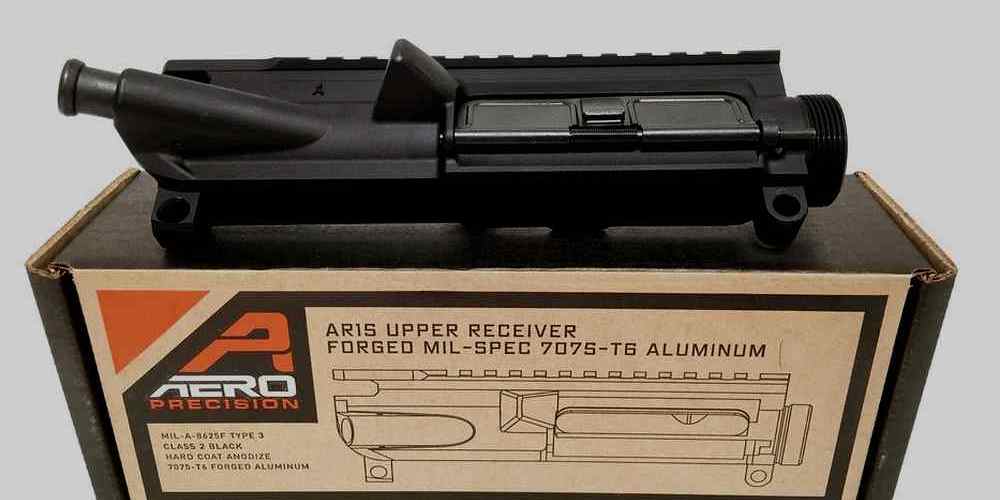“Enhancing precision and versatility with integrated optics on the AR15 upper receiver rail system.”
Advantages of Integrating Optics into AR15 Upper Receiver Rail Systems
The AR15 is a popular and versatile rifle platform that has been used by military, law enforcement, and civilian shooters for decades. One of the key features of the AR15 is its upper receiver rail system, which allows for the easy attachment of accessories such as optics, lights, and grips. In recent years, there has been a growing trend towards integrating optics directly into the upper receiver rail system, rather than mounting them on top of the rifle.
There are several advantages to integrating optics into the AR15 upper receiver rail system. One of the main benefits is improved ergonomics. By mounting the optic closer to the bore axis of the rifle, shooters can achieve a more natural and comfortable shooting position. This can help to reduce fatigue during long shooting sessions and improve accuracy.
Another advantage of integrating optics into the upper receiver rail system is increased stability. By mounting the optic directly to the rifle, rather than on a separate mount, shooters can ensure that the optic remains securely in place, even under heavy recoil. This can help to maintain zero and ensure consistent accuracy over time.
Integrating optics into the upper receiver rail system can also help to streamline the overall profile of the rifle. By eliminating the need for a separate optic mount, shooters can achieve a cleaner and more compact look. This can be particularly beneficial for shooters who need to move quickly and quietly in tight spaces, such as law enforcement or military personnel.
In addition to these practical advantages, integrating optics into the upper receiver rail system can also offer performance benefits. By mounting the optic closer to the bore axis of the rifle, shooters can achieve a lower sight height over bore axis, which can help to reduce the effects of bullet drop and improve accuracy at longer ranges. This can be particularly important for shooters who need to engage targets at varying distances.
There are several different ways to integrate optics into the AR15 upper receiver rail system. One common method is to use a cantilever mount, which extends forward from the upper receiver rail and positions the optic over the rifle’s bore. This can help to achieve a more natural shooting position and improve eye relief.
Another option is to use a low-profile mount, which positions the optic closer to the rifle’s bore axis. This can help to reduce the overall profile of the rifle and improve stability. Some shooters also choose to use a riser mount, which raises the optic slightly above the upper receiver rail. This can help to achieve a more comfortable shooting position and improve sight picture.
Overall, integrating optics into the AR15 upper receiver rail system can offer a range of benefits, including improved ergonomics, stability, and performance. By choosing the right mounting method and optic for your needs, you can enhance the capabilities of your rifle and take your shooting to the next level. Whether you are a competitive shooter, a hunter, or a tactical operator, integrating optics into your AR15 upper receiver rail system can help you achieve your goals with confidence and precision.

How to Properly Mount Optics on an AR15 Upper Receiver Rail System
The AR15 is a popular rifle platform known for its versatility and modularity. One key component of the AR15 is the upper receiver rail system, which allows for the mounting of various accessories, including optics. Properly mounting optics on an AR15 upper receiver rail system is crucial for achieving optimal performance and accuracy.
When it comes to mounting optics on an AR15 upper receiver rail system, there are a few key factors to consider. The first step is to ensure that the rail system is compatible with the specific type of optic you plan to mount. Most AR15 upper receiver rail systems feature a Picatinny or Weaver rail, which are standardized rail systems that allow for easy attachment of accessories.
Once you have determined that your optic is compatible with your AR15 upper receiver rail system, the next step is to properly position the optic on the rail. It is important to mount the optic as far forward on the rail as possible to maximize eye relief and field of view. Additionally, make sure that the optic is securely mounted to the rail to prevent any movement or shifting during use.
When mounting the optic, be sure to use the appropriate mounting hardware and follow the manufacturer’s instructions carefully. This will help ensure that the optic is properly aligned and securely attached to the rail system. It is also a good idea to use a torque wrench to tighten the mounting hardware to the manufacturer’s recommended specifications to prevent over-tightening and potential damage to the optic or rail system.
Once the optic is securely mounted to the AR15 upper receiver rail system, it is important to zero the optic to ensure that it is properly aligned with the rifle’s point of impact. This can be done by adjusting the windage and elevation settings on the optic until the point of aim matches the point of impact at a specific distance. It is recommended to zero the optic at a distance that is practical for your intended use, such as 100 yards for general shooting or hunting.
After zeroing the optic, it is a good idea to test the rifle and optic combination at various distances to ensure that it is accurate and reliable. This can be done by shooting groups at different distances and adjusting the optic as needed to maintain consistent accuracy. It is also important to practice proper shooting techniques and follow safety guidelines when using optics on an AR15 upper receiver rail system.
In conclusion, properly mounting optics on an AR15 upper receiver rail system is essential for achieving optimal performance and accuracy. By following the steps outlined above and taking the time to ensure that the optic is securely mounted and properly zeroed, you can maximize the effectiveness of your AR15 rifle platform. Remember to always follow manufacturer’s instructions and practice safe shooting habits when using optics on your AR15.
Comparison of Different Optics for AR15 Upper Receiver Rail Systems
When it comes to choosing optics for your AR15 upper receiver rail system, there are a variety of options to consider. Each type of optic has its own strengths and weaknesses, so it’s important to understand the differences between them in order to make an informed decision. In this article, we will compare and contrast some of the most popular optics for AR15 upper receiver rail systems, including red dot sights, holographic sights, and magnified scopes.
Red dot sights are a popular choice for AR15 owners due to their simplicity and ease of use. These sights project a red dot onto a lens that is superimposed over the target, allowing for quick and accurate target acquisition. Red dot sights are ideal for close to medium range shooting, making them a great choice for tactical applications or home defense. One of the main advantages of red dot sights is their unlimited eye relief, which allows shooters to maintain a full field of view while aiming.
Holographic sights are another popular option for AR15 upper receiver rail systems. These sights use a laser to project a holographic reticle onto a lens, providing a clear and precise aiming point. Holographic sights are known for their durability and reliability, making them a favorite among military and law enforcement personnel. One of the key benefits of holographic sights is their ability to maintain zero even after being bumped or dropped, ensuring consistent accuracy in any situation.
Magnified scopes are a more traditional option for AR15 upper receiver rail systems, offering shooters the ability to engage targets at longer distances with increased precision. These scopes come in a variety of magnification levels, ranging from 1-4x for close to medium range shooting, up to 6-24x for long range precision shooting. Magnified scopes are ideal for hunters and competitive shooters who require pinpoint accuracy at extended ranges. One of the main advantages of magnified scopes is their ability to zoom in on targets for increased clarity and precision.
When comparing these different optics for AR15 upper receiver rail systems, it’s important to consider your intended use and shooting preferences. Red dot sights are great for fast target acquisition at close to medium ranges, while holographic sights offer durability and reliability in any situation. Magnified scopes are ideal for shooters who require precision at longer distances, making them a popular choice for hunting and long range shooting competitions.
In conclusion, the AR15 upper receiver rail system offers a versatile platform for integrating optics of your choice. Whether you prefer the simplicity of a red dot sight, the durability of a holographic sight, or the precision of a magnified scope, there is an optic to suit your needs. By understanding the differences between these optics and considering your shooting preferences, you can make an informed decision on the best optic for your AR15 upper receiver rail system.
Tips for Zeroing Optics on an AR15 Upper Receiver Rail System
When it comes to setting up your AR15 upper receiver rail system with optics, there are a few key tips to keep in mind to ensure that you achieve the best performance possible. Zeroing your optics is a crucial step in the process, as it ensures that your rifle is accurately sighted in and ready for action. In this article, we will discuss some important considerations and techniques for zeroing optics on an AR15 upper receiver rail system.
First and foremost, it is important to understand the basics of zeroing your optics. Zeroing refers to the process of aligning your sights with the point of impact of your bullets at a specific distance. This ensures that when you aim at a target, your bullets will hit where you are aiming. To zero your optics, you will need to adjust the windage and elevation settings on your scope or red dot sight until your shots are hitting the target where you want them to.
One of the most important tips for zeroing optics on an AR15 upper receiver rail system is to ensure that your rifle is properly mounted and stable. This means using a solid shooting rest or bipod to support the rifle and eliminate any movement that could affect your shots. Additionally, make sure that your rifle is securely mounted to the rail system to prevent any shifting or movement during the zeroing process.
Another key tip is to start zeroing your optics at a relatively close distance, such as 25 yards. This will allow you to quickly make adjustments and see the results of your changes without having to walk back and forth to a longer distance target. Once you have achieved a good zero at 25 yards, you can then move on to zeroing at longer distances, such as 100 yards or more.
When zeroing your optics, it is important to make small, incremental adjustments to your windage and elevation settings. This will allow you to fine-tune your zero without overcompensating and potentially throwing off your shots. Additionally, be sure to take your time and shoot multiple groups to ensure that your zero is consistent and repeatable.
It is also important to consider the type of ammunition you are using when zeroing your optics. Different types of ammunition can have varying ballistic characteristics, which can affect your zero. It is a good idea to zero your optics with the same type of ammunition that you plan to use for shooting purposes to ensure the most accurate results.
Finally, don’t be afraid to seek out help or advice from experienced shooters or gunsmiths when zeroing your optics. They can offer valuable insights and tips to help you achieve the best possible zero for your AR15 upper receiver rail system. Remember, zeroing your optics is a critical step in ensuring that your rifle is accurate and reliable in any shooting situation.
In conclusion, zeroing optics on an AR15 upper receiver rail system is a crucial step in setting up your rifle for success. By following these tips and techniques, you can achieve a precise and reliable zero that will help you make accurate shots every time. So, take your time, be patient, and don’t hesitate to seek out help if needed. Happy shooting!
Maintenance and Care of Optics Integrated into AR15 Upper Receiver Rail Systems
When it comes to maintaining and caring for optics integrated into AR15 upper receiver rail systems, there are a few key things to keep in mind. These systems are designed to provide shooters with a versatile platform for attaching various accessories, including scopes, red dot sights, and other optics. Proper maintenance is essential to ensure that these optics perform optimally and remain in good working condition.
One of the most important aspects of maintaining optics integrated into AR15 upper receiver rail systems is keeping them clean. Dust, dirt, and debris can accumulate on the lenses of the optics, affecting their clarity and performance. To clean the lenses, use a soft, lint-free cloth and a mild cleaning solution specifically designed for optics. Avoid using harsh chemicals or abrasive materials, as these can damage the lenses.
In addition to cleaning the lenses, it is also important to regularly check the mounting hardware of the optics. Over time, the screws and bolts that secure the optics to the rail system can become loose, potentially causing the optics to shift or become misaligned. To prevent this from happening, periodically check the mounting hardware and tighten any loose screws or bolts as needed.
Another important aspect of maintaining optics integrated into AR15 upper receiver rail systems is protecting them from the elements. Exposure to moisture, extreme temperatures, and other environmental factors can damage the optics and affect their performance. To protect the optics, consider using lens covers or caps when not in use, and store them in a dry, climate-controlled environment.
When it comes to caring for optics integrated into AR15 upper receiver rail systems, proper storage is key. Optics should be stored in a secure location where they are protected from damage and theft. Consider investing in a padded case or storage box specifically designed for optics to keep them safe when not in use.
Regularly inspecting the optics for signs of wear or damage is also important. If you notice any cracks, scratches, or other issues with the lenses or housing of the optics, it is important to address these issues promptly to prevent further damage. In some cases, it may be necessary to replace the optics entirely if they are beyond repair.
Overall, maintaining and caring for optics integrated into AR15 upper receiver rail systems is essential to ensure that they perform optimally and remain in good working condition. By keeping the lenses clean, checking the mounting hardware, protecting the optics from the elements, storing them properly, and inspecting them regularly for signs of wear or damage, shooters can enjoy reliable and accurate performance from their optics for years to come.







